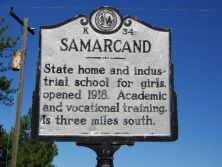See also: Samarcand Manor (Encyclopedia of North Carolina)

Samarcand, the State Home and Industrial School for Girls, was established in 1918 as a correctional institute for young women. The concept of the school originated through the work of Presbyterian minister A. A. McGeachy, who believed the state needed a protective care center for delinquent juvenile girls, many of whom were vagrants and prostitutes.
Named for a Persian city conquered by Alexander the Great, Samarcand was located on 230 acres that had been the Marienfield Open Air School for Boys. The school officially opened on September 17, 1918, and operated as a female counterpart to the Stonewall Jackson Training School in Concord. Dr. McGeachy was elected first president of the board of trustees and subsequently appointed schoolteacher Agnes B. MacNaughton as first superintendent.
By 1919, Samarcand housed more than 200 females between the ages of ten and twenty-five. The school curriculum consisted of Biblical studies, music, science, and math. In addition, the girls received training in weaving, canning, and laundry preparation, as well as working on the chicken and cattle farm adjacent to the facility. In 1930, the administration opened an accredited high school on the campus, as well as a hospital.
Discipline at Samarcand could be harsh. Corporal punishment, in addition to solitary confinement, was often administered to the young women who misbehaved. In 1931, sixteen inmates set fire to two of the dormitories. They were charged with arson, and twelve of them set fire to their cells in prison. Eight eventually saw prison time. A 1940 account of the disciplinary ward described mattresses on the floor with no beds and a single washbasin and toilet for nearly thirty girls.
Samarcand survived the Great Depression and the loss of many male staff during World War II. The state officially renamed the school Samarcand Manor in 1974 and transferred it from the Department of Corrections to the Department of Human Services. Samarcand remained a rehabilitation center for delinquent children and began admitting male patients as well. In 2002, state officials decided to return Samarcand to an all female institution. Samarcand closed in 2011.